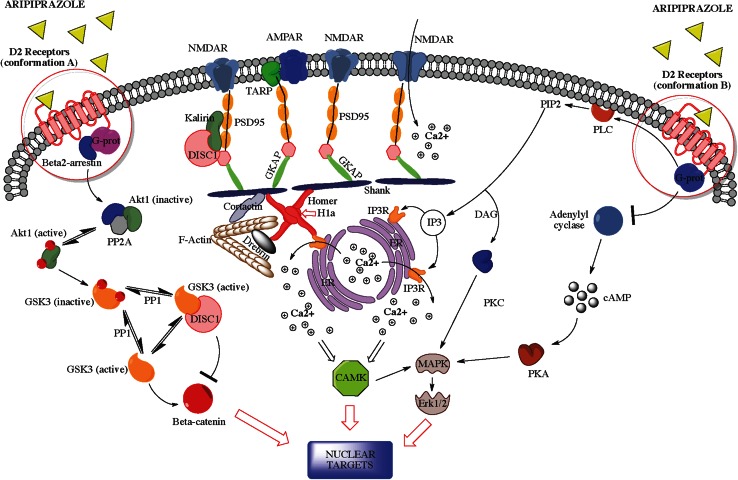Fig. 1.
Postsynaptic functional selectivity of aripiprazole. Aripiprazole is supposed to cause functional multiplicity at dopamine D2 receptors postsynaptic downstream pathways. One mechanism of functional selectivity may be the preferential binding to different conformations of D2 receptors, which have been demonstrated to activate differential transductional pathways according to the neuronal subtypes in which they are expressed. Postsynaptic scaffolding/adaptors and effectors may be differentially impacted by each dopamine D2 receptor conformation-related pathway selectively activated by aripiprazole. AMPAR α-amino-3-hydroxy-5-methyl-4-isoxazolepropionic acid glutamate receptor, CAMK calcium-calmodulin regulated kinase, cAMP cyclic adenosine monophosphate, DAG diacylglycerol, DISC1 disrupted in schizophrenia 1, ER endoplasmic reticulum, Erk extracellular signal-regulated kinase, GKAP guanylate kinase-associated protein, GSK3 glycogen synthase kinase 3, H1a Homer1a immediate-early inducible protein, IP3 inositol 1,4,5-trisphosphate, MAPKs mitogen-activated protein kinases, MEK MAPK/Erk kinase, nMDAR N-methyl-d-aspartate glutamate receptor, PDE4 phosphodiesterase 4, PIP2 phosphatidylinositol bisphosphate, PKA protein kinase A, PKC protein kinase C, PLC phospholipase C, PSD-95 postsynaptic density protein 95kD, TARP transmembrane AMPA receptors regulating protein or stargazin

